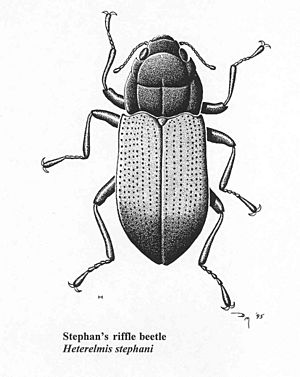Stephan's riffle beetle facts for kids
Quick facts for kids Stephan's riffle beetle |
|
|---|---|
 |
|
| Conservation status | |
| Scientific classification | |
| Genus: |
Heterelmis
|
| Species: |
stephani
|
The Heterelmis stephani was a very rare type of water beetle. People often called it Stephan's riffle beetle. This tiny beetle lived only in Arizona, in the Santa Rita Mountains of the United States. Sadly, it is now thought to be extinct, meaning it no longer exists.
What Was Stephan's Riffle Beetle Like?
This special beetle was first found in 1969 by a person named Karl Stephan from Tucson, Arizona. The beetle was named after him! In 1972, a scientist named Harley Brown officially described it as a new species.
Karl Stephan first collected seven beetles in 1969. He sent them to Dr. Brown to identify. When Dr. Brown realized they were a new species, he asked for more. So, in 1970, Stephan collected one young beetle (called a larva) and 64 adult beetles.
- Size: Stephan's riffle beetle was very small. It was about 2.3 to 2.6 millimeters (mm) long. That's less than a quarter of a centimeter! It was also about 1.05 to 1.2 mm wide.
- Color: These beetles were mostly light to dark brown. Some parts of their bodies were a reddish-brown color.
- Appearance: Both male and female beetles looked quite similar. They had many tiny black dots on their wings.
Riffle beetles are water insects. They live underwater for most of their lives. They only leave the water when they are changing from a larva to an adult. Once they become adults and return to the water, they lose their wings. This means they can no longer fly.
These beetles need water with lots of oxygen to survive. They eat plants, decaying material, and a slimy layer of tiny living things called biofilm.
Scientists sent samples of this beetle to different museums around the world. This helped other researchers study and learn about this new species.
Where Did Stephan's Riffle Beetle Live?
Stephan's riffle beetle was only found in a place called Madera Canyon. This canyon is on the side of the Santa Rita Mountains in the Coronado National Forest in southeastern Arizona.
Specifically, the beetle lived in just two spots: Bog Spring and Sylvester Spring. When it was first discovered at Bog Spring, the beetles were living near a leaky pipe. This pipe was taking water from the spring to a nearby campground. The leak created a wet area that was perfect for the beetles.
Why Did It Disappear?
In 1984, the United States Fish and Wildlife Service (USFWS) said that this beetle needed help to survive. A big problem happened in 1976 when the leaky pipe at Bog Spring was fixed. When the pipe was repaired, the wet area where the beetles lived disappeared.
The beetle was seen a few more times when other water pipes leaked in 1972 and 1987. However, it was never found in the natural water flow of the spring itself. The last time anyone saw Stephan's riffle beetle was in 1993 at Sylvester Spring.
Between 2012 and 2016, the USFWS searched for the beetle many times. They looked in Sylvester Spring and seven other places where the beetle might have lived. They used different ways to search, but they could not find any beetles.
In 2016, the USFWS announced that Stephan's riffle beetle had not been seen for over twenty years. Because of this, they believed the beetle was extinct. This meant it could no longer be protected by special laws for endangered animals, as it was already gone.


